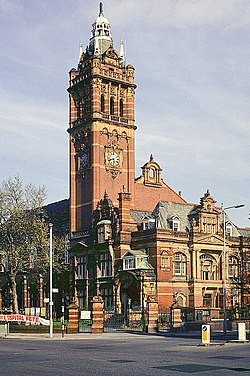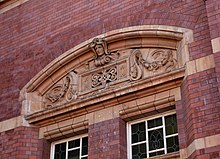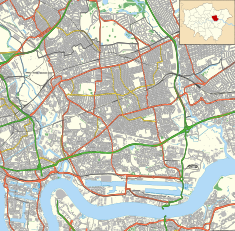| Newham Town Hall | |
|---|---|
 Newham Town Hall | |
| Location | Barking Road, East Ham |
| Coordinates | 51°31′57″N 0°03′19″E / 51.5326°N 0.0554°E |
| Built | 1903 |
| Architect | Henry Cheers and Joseph Smith |
| Architectural style(s) | Renaissance style |
Listed Building – Grade II* | |
| Designated | 31 January 1973 |
| Reference no. | 1190712 |
Newham Town Hall, formerly East Ham Town Hall, is a municipal building in Barking Road, East Ham, London. The town hall, which is the headquarters of Newham London Borough Council, is a Grade II* listed building. [1]
History
In the early 20th century the East Ham Urban District Council held its meetings in the local school board offices in Wakefield Street. [2] Following a rapid growth in the local population, [3] civic leaders decided to procure purpose-built council offices: the site chosen for the new building was a plot of open land on the corner of Barking Road and High Street South. [4]

The foundation stone for the new building was laid in 1901. [5] It was designed by Henry Cheers and Joseph Smith in the Renaissance style, built by D.W. Barker and was officially opened by the philanthropist, John Passmore Edwards, on 5 February 1903. [6] The design involved an asymmetrical main frontage with six bays facing onto Barking Road; the right hand section featured a 150 foot (46 m) high tower and a large archway to the extreme right inscribed with the words "Public Hall" above. [1] [7] The tower contained a clock by Smith & Sons of Derby, [8] and an hour bell cast by John Taylor & Co of Loughborough, which weighed almost a ton (19cwt). [9] A long extension to the south of the main building was completed in 1910 and a three-storey annex was built to the east on Barking Road in 1939. [3] Internally, the principal rooms were the public hall, the council chamber and the mayor's parlour. [1]
It was built to serve as the administrative headquarters of East Ham Urban District Council. The East Ham Urban District was given municipal borough status in 1904; [10] and county borough status in 1915. [11] The building continues to be the local seat of government after the formation of the London Borough of Newham in 1965, serving as its administrative headquarters. [12]
An additional building in Stratford, which was designed by the borough architect, Ken Lund, and Norman White in the shape of a ziggurat, was completed in May 1976; it was to have been joined by another, larger ziggurat, but after reductions in funding and criticism of the design the original ziggurat was demolished in February 1998. [13]

Most council officers and their departments were re-located to Newham Dockside (Building 1000 in Dockside Road) in 2010. [14] The building had been designed by Aukett Swanke and developed by Development Securities, Standard Life Investments and the London Development Agency as part of a scheme to regenerate the Royal Albert Dock; it had been built by Bowmer + Kirkland at a cost of £70 million and had been completed in June 2004. [15] [16] After the developers had been unable to secure tenants, Newham Council acquired the building for £92 million and initiated a programme of fit-out works at a further cost of £19 million. [17] However, formal meetings of the council continue to take place in the town hall. [18]
References
- ^ a b c Historic England. "Newham Council Offices (1190712)". National Heritage List for England. Retrieved 9 May 2020.
- ^ Powell, W R (1973). "'East Ham: Local government and public services', in A History of the County of Essex". London: British History Online. pp. 18–24. Retrieved 12 September 2020.
- ^ a b "London's Town Halls". Historic England. p. 156. Retrieved 9 May 2020.
- ^ "Ordnance Survey Map". 1898. Retrieved 12 September 2020.
- ^ "Let's hear it for East Ham - a town with a proud history". Newham Recorder. 10 April 2020. Retrieved 12 September 2020.
- ^ "Restoration makes the Grade". The Newham Magazine. 20 July 2012. Retrieved 9 May 2020.
- ^ "The Civic Plunge Revisited" (PDF). Twentieth Century Society. 24 March 2012. Retrieved 25 April 2020.
- ^ Mercer, Vaudrey (1977). The Life and Letters of Edward John Dent, Chronometer Maker, and Some Account of His Successors. London: The Antiquarian Horological Society. p. 528.
- ^ Deedes, Cecil; Walters, Henry Beauchamp (1909). The Church Bells of Essex Their Founders, Inscriptions, Traditions, and Uses. Aberdeen: W. Jolly & Sons. p. 142.
- ^ "The Incorporation of East Ham". The Times. 15 September 1904. p. 6.
- ^ "New London County Borough". The Times. 13 March 1914.
- ^ "Local Government Act 1963". Legislation.gov.uk. Retrieved 25 April 2020.
- ^ "The Ziggurat Building". Stratford Explorers. Retrieved 12 September 2020.
- ^ "Newham Council 'may quit £111m office'". BBC. 23 September 2013. Retrieved 9 May 2020.
- ^ "Behemoth in steel and glass". Building. 25 June 2004. Retrieved 9 May 2020.
- ^ "The Royals". BBC. Retrieved 9 May 2020.
- ^ "Deprived Newham watches bemused as council ponders move from £110m building after just three years". The Independent. 24 September 2013. Archived from the original on 18 June 2022. Retrieved 9 May 2020.
- ^ "Discussions to take place on budget proposals; Newham Town Hall". London Borough of Newham. 18 February 2020. Retrieved 9 May 2020.
